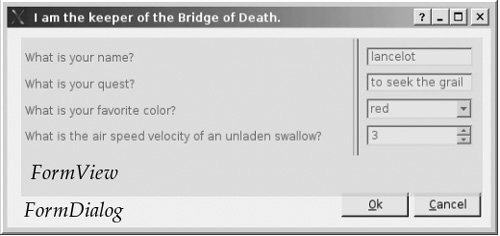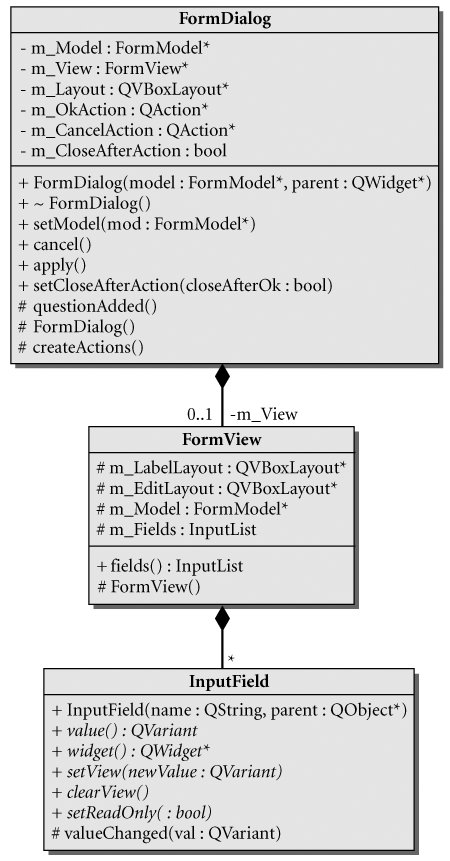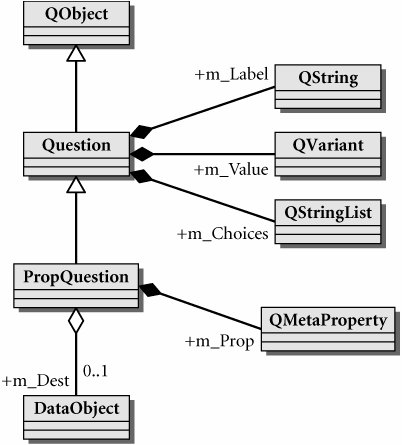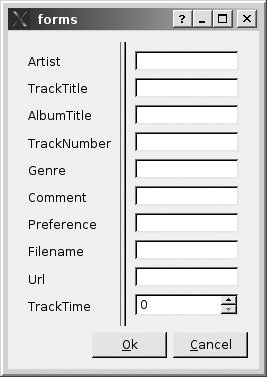Dynamic Form Models
A collection of questions and blanks to fill in the answers is called a form. Quite common in GUI applications, a form is used whenever a series of questions needs to be asked of the user. There are many ways to design and implement forms. In this section, we will make a model for the form, and then a view for it.
Example 17.1. src/libs/forms/testform.cpp
[ . . . . ]
class BridgeKeeper : public FormModel {
public:
BridgeKeeper();
};
BridgeKeeper::BridgeKeeper() {
FormFactory ff;
*this << ff.newQuestion("name", "What is your name?");
*this << ff.newQuestion("quest", "What is your quest?");
QStringList colors;
colors << "red" << "blue" << "green" << "orange";
*this << ff.newQuestion("color",
"What is your favorite color?",colors);
*this << ff.newQuestion("speed",
"What is the mean air speed of an unladen swallow?",
QVariant::Int);
}
|
The model created in Example 17.1 represents a form containing questions of different "types," where the first two are simple string inputs, but the last two are constrained to a set of possible values. The main program creates a model and a view, and hooks them together. In Example 17.2, you can think of main as the controller.
Example 17.2. src/libs/forms/testform.cpp
[ . . . . ]
int main(int argc, char** argv) {
QApplication a(argc, argv);
QMainWindow mw;
BridgeKeeper keeper;
qDebug() << keeper.toString();
FormDialog fv(&keeper);
fv.setWindowTitle("I am the keeper of the Bridge of Death.");
mw.setCentralWidget(&fv);
mw.setVisible(true);
int retval = a.exec();
QVariant speed = keeper.property("speed");
QVariant color = keeper.property("color");
QVariant quest = keeper.property("quest");
QVariant name = keeper.property("name");
if (color.toString() == "blue") {
qDebug() << "no, I mean red! aaaaaaahhhhhhhhhhh!" ;
}
else {
qDebug() << "My name is " << name.toString()
<< ", and I " << quest.toString()
<< ". My favorite color is " << color.toString()
<< ". The speed is " << speed.toInt();
}
return retval;
}
|
In Example 17.2, you can think of main as the controller.
The FormDialog below is automatically generated from the model above, even though it does not depend on the specific model.

The dialog embeds a FormView, which contains the actual input widgets.
- View classes access Questions only through the public polymorphic interface.
- Model classes emit signals to communicate information to views, instead of invoking objects directly through references or pointers passed around as function parameters.
- The code that does depend on both model and view (or on specific types of Question) is kept separate as controller code.
A FormModel wraps a collection of Questions, which are model classes. A FormView wraps a collection of InputFields, which are views (because they derive from QWidget), but encapsulate complex input widgets.
In the Doxygen collaboration diagram in Figure 17.2, there is a 1:1 correspondence between InputField and Question, but the classes are strictly decoupled.[1]
[1] "Strictly decoupled" means that they know nothing about each other.
Figure 17.2. Forms

A Question models (ideally) all of the information needed by FormFactory to create an appropriate InputField. A FormView is a grouping of input widgets. An input widget serves as a proxy, or delegate, between Qt input widgets and Question-derived models.
|
The Strategy pattern encapsulates each member of a family of algorithms so that they can be selected independently by clients. Each encapsulated algorithm is called a strategy. |
Figure 17.3 shows that an InputField can be a variety of things. Because Qt input widgets[2] do not have a common QVariant-based interface for getting and setting data, the InputField serves as an adaptor, that provides a property-like interface. InputField uses the Strategy pattern to organize the getters and setters for different types as virtual functions.
[2] QLineEdit, QComboBox, QDateEdit, QSpinBox
Figure 17.3. Input fields

With a hierarchy of views, we end up with an extensible framework for adding other kinds of InputFields later.
Exercises: Dynamic Form Models
| 1. |
Add a DoubleInputField class, derived from InputField, and update the FormFactory to return it as needed. |
| 2. |
Write a testcase with a QVariant Question in it, and verify that a QDoubleSpinBox shows up. |
17.2.1. Form Models
In addition to different kinds of input widgets (for the different data types), there can also be different kinds of Question models for getting/setting the data in different places.
The FormModel and the Question classes, shown in Figure 17.4, are two adjoining layers in the model. Because they are models, they are meant to be very simple classes, holding data but containing no GUI or controller code.
Figure 17.4. FormModel and Question

FormModel provides a simple operation, setValues(), for updating all of its Question's values, shown in Example 17.3.
Example 17.3. src/libs/forms/formmodel.cpp
[ . . . . ]
bool FormModel::setValues(QList list) {
bool retval = true;
for (int i=0; isetValue(str) && retval;
}
emit modelChanged();
return retval;
}
|
Question encapsulates all the things that are needed for an interaction with a user, including the type and value of the expected answer. The constructors, declared in Example 17.4, are protected because we will use a factory to create Question objects.
Example 17.4. src/libs/forms/question.h
[ . . . . ]
class Question : public QObject {
Q_OBJECT
protected:
Question(QString name, QString label = QString(),
QVariant::Type type=QVariant::String);
Question(QString name, QString label,
QStringList choices, bool open=false);
Question() {}
public:
virtual Qt::ItemFlags flags() const;
virtual QString toString() const;
virtual QVariant value() const;
virtual QVariant::Type type() const ;
QStringList choices() const ;
QString label() const {return m_Label;}
virtual ~Question() {}
public slots:
virtual bool setValue(QVariant newValue);
signals:
void valueChanged();
protected:
void setType(QVariant::Type type) ;
void setLabel(QString label) ;
private:
QString m_Label;
QVariant m_Value;
QStringList m_Choices;
QVariant::Type m_Type;
};
[ . . . . ]
|
When we need a Question instance, FormFactory creates it by using one of the protected constructors, defined in Example 17.5.
Example 17.5. src/libs/forms/question.cpp
[ . . . . ]
Question::Question( QString name, QString label, QVariant::Type t):
m_Label(label) {
setObjectName(name);
if (m_Label == QString())
m_Label = name;
m_Value = QVariant(t);
m_Type = m_Value.type();
}
Question::Question( QString name, QString label, QStringList choices,
bool) : m_Label(label), m_Choices(choices) {
setObjectName(name);
if (m_Label == QString())
m_Label = name;
m_Type = QVariant::StringList;
}
|
17.2.2. Form Views
The view classes, shown in Figure 17.5, are separated into three layers.
- FormDialog includes the buttons and actions plus some management/ controller code.
- FormView is solely responsible for holding layouts for labels and input widgets.
- InputField is responsible for a single input widget.
Figure 17.5. Form views

FormView can be automatically created from a FormModel without any knowledge of the individual InputField or Question types. This is thanks to the createEditor Factory method, used in Example 17.6, which returns polymorphic objects.
Example 17.6. src/libs/forms/formfactory.cpp
[ . . . . ]
FormView* FormFactory::formView(FormModel* mod) {
FormView* retval = new FormView();
retval->m_Model = mod;
retval->m_LabelLayout = new QVBoxLayout();
retval->m_EditLayout = new QVBoxLayout();
foreach (Question* q, mod->questions()) {
QLabel* label = new QLabel(q->label());
retval->m_LabelLayout->addWidget(label);
InputField* editField = createEditor(q); <-- 1
retval->m_Fields += editField;
label->setBuddy(editField->widget());
retval->m_EditLayout->addWidget(editField->widget());
}
QWidget* labels = new QWidget();
labels->setLayout(retval->m_LabelLayout);
QWidget* edits = new QWidget();
edits->setLayout(retval->m_EditLayout);
retval->addWidget(labels);
retval->addWidget(edits);
return retval;
}
|
The specific InputField types that get created depend on the type of the Question passed in, and that is determined in FormFactory, shown in Example 17.7.
Example 17.7. src/libs/forms/formfactory.cpp
[ . . . . ]
InputField* FormFactory::createEditor(Question* q) {
QVariant::Type type = q->type();
InputField* retval = 0;
switch(type) {
case QVariant::StringList:
retval = new ChoiceInputField(
q->objectName(), q->choices());
break;
case QVariant::String:
retval = new StringInputField(q->objectName());
break;
case QVariant::Int:
retval = new IntInputField(q->objectName());
break;
case Variant::Dir:
retval = new DirInputField(q->objectName());
break;
default:
retval=new StringInputField(q->objectName(), 0);
qDebug() << QString("Unknown property type %1").arg(type);
}
if (q->flags() != Qt::ItemIsEditable) {
retval->setReadOnly(true);
}
return retval;
}
|
In Example 17.7, notice the switch statement, which is normally to be avoided in object-oriented code. We have it here to map polymorphically from the QVariant::Type (an enumerated value) to an InputField class. This makes it possible for us to use the Strategy pattern on InputField (which provides input and output in various ways, on various types).
By default, createEditor() returns a StringInputField, shown in Example 17.8. It has a simple QLineEdit as its input widget.
Example 17.8. src/libs/forms/inputfields.h
[ . . . . ]
class StringInputField : public InputField {
Q_OBJECT
public:
StringInputField(QString name, QWidget* parent = 0);
QVariant value() const ;
QWidget* widget() const ;
public slots:
void setReadOnly(bool v);
void setView(QVariant qv);
void clearView();
protected:
QLineEdit *qle;
};
|
17.2.3. Unforseen Types
It is possible there will be other "types" of data that correspond to different kinds of input widgets, but are not among those defined in QVariant. In Example 17.9, we introduce user-defined enumerated values above QVariant (127) that will not share a value with those already predefined in QVariant::Type.
Example 17.9. src/libs/dataobjects/variant.h
#ifndef VARIANT_H
#define VARIANT_H
#include
namespace Variant {
const QVariant::Type File = static_cast
|
A directory can be encoded and decoded as a QString quite naturally, but a Question with a Variant::Directory as its type gives a hint to the FormFactory that the input widget it creates should be a QFileDialog that is already in "directory-chooser" mode.
Example 17.10. src/libs/forms/dirinputfield.h
[ . . . . ]
class DirInputField : public StringInputField {
Q_OBJECT
public:
DirInputField(QString name);
QWidget* widget() const;
void clearView();
static void setFileDialog(QFileDialog* fd) {
sFileDialog = fd;
}
public slots:
void browse();
private:
QHBoxLayout *m_Layout;
QPushButton *m_Button;
QWidget *m_Widget;
static QFileDialog* sFileDialog;
};
[ . . . . ]
|
The DirInputField, defined in Example 17.10, extends the StringInputField and still has the QLineEdit for accepting a string from the user. In addition, there is a Browse button, which when clicked will pop up a QFileDialog pre-set to accept only a directory as a valid selection.
17.2.4. Controlling Actions
In this section, we discuss issues of synchronizing data between the model and the view. Since these methods depend on both model and view, we are going to isolate them from both, in their own controller classes. In Example 17.11, we derived two custom QAction classes, each responsible for synchronizing in one direction.
Example 17.11. src/libs/forms/formactions.h
[ . . . . ]
class OkAction : public QAction {
Q_OBJECT
public:
OkAction(FormModel* model, FormView* view);
public slots:
void ok();
private:
FormModel *m_Model;
FormView *m_View;
};
class CancelAction : public QAction {
Q_OBJECT
public slots:
void cancel();
[ . . . . ]
|
OkAction (or apply) should send the data from the view to the model. CancelAction, in the case where the dialog is not to be closed afterwards, should do the opposite (send the data from the model back to the view, to restore old or set default values). Their definitions are in Example 17.12.
Example 17.12. src/libs/forms/formactions.cpp
#include
#include "formactions.h"
#include "formmodel.h"
#include "formview.h"
#include "inputfield.h"
#include "question.h"
OkAction::OkAction(FormModel* model, FormView* view) :
QAction( tr("&Ok"), view), m_Model(model), m_View(view) {
connect (this, SIGNAL(triggered()), this, SLOT(ok()));
}
void OkAction::ok() {
qDebug() << "OK()" << endl;
QList values;
InputList fields = m_View->fields();
foreach (InputField* field, fields) {
QVariant v = field->value();
qDebug() << "submitting value: " << v.toString();
values += v;
}
m_Model->setValues(values);
qDebug() << m_Model->toString();
}
CancelAction::CancelAction(FormModel* model, FormView* view) :
QAction( tr("&Cancel"), view), m_Model(model), m_View(view) {
connect (this, SIGNAL(triggered()), this, SLOT(cancel()));
}
void CancelAction::cancel() {
qDebug() << "Cancel() " << endl;
QList qlist = m_Model->questions();
InputList fields = m_View->fields();
for (int i=qlist.size()-1; i>-1; --i) {
Question* q = qlist.at(i);
InputField* f = fields.at(i);
qDebug() << QString(" name: %1 val: %2")
.arg(q->objectName())
.arg(q->value().toString());
f->setView(q->value());
}
}
|
These actions are in fact delegates, and perform a similar function to Qt's QItemDelegate.
17.2.5. DataObject Form Model
In Example 17.1, we extended FormModel, and in the constructor we created and added Question objects to compose a custom form. The FormModel itself can be used in other ways, including those listed below.
- Creating a FormModel from a DataObject (one Question per property)
- Connecting fields of a FormModel to QSettings values, to give persistence
- Importing and exporting in XML[3]
[3] This is how Designer recreates its GUIs.
- Importing and exporting in HTML[4]
[4] Basically, this is similar to importing and exporting in XML, except that the tags we use, <form> and <input>, are specified by the W3C [w3c]. By using this format, we can create XHTML forms and load them in as FormModels.
- Can you think of others?
We wish to create a FormModel from a DataObject, so this means that another function goes into the ModelFactory. We extended Question, the basic FormModel building block, so that it would get/set values from/to a DataObject property instead of its own m_Value.
PropQuestion, shown in Figure 17.6, serves as a proxy or delegate between a DataObject property and an InputField widget. We see this in Example 17.13: Most of the methods simply pass on the request to the underlying DataObject, mDest.
Figure 17.6. Rephrasing the question

Example 17.13. src/libs/forms/propquestion.cpp
#include "propquestion.h"
#include
#include
PropQuestion::PropQuestion(QString name, DataObject* dest):
m_Dest(dest) {
setObjectName(name);
m_Prop = m_Dest->metaProperty(name);
setLabel(name);
setType(m_Prop.type());
}
Qt::ItemFlags PropQuestion::flags() const {
if (m_Prop.isWritable()) return Qt::ItemIsEditable;
else return Qt::ItemIsSelectable;
}
QVariant PropQuestion::value() const {
return m_Dest->property(objectName());
}
bool PropQuestion::setValue(QVariant newValue) {
return m_Dest->setProperty(objectName(), newValue);
}
|
Example 17.14 uses the DataObject model applied to the FileTagger class to auto-generate a form, which looks like Figure 17.7.
Figure 17.7. Auto-generated FileTagger form

Example 17.14. src/libs/forms/testform2.cpp
#include
#include
#include "formfactory.h"
#include "formdialog.h"
#include "formmodel.h"
#include "filetagger.h"
int main(int argc, char** argv) {
QApplication a(argc, argv);
QMainWindow mw;
FileTagger ft;
FormModel* mod = FormFactory::newForm(&ft);
FormDialog dialog(mod);
mw.setCentralWidget(&dialog);
mw.setVisible(true);
return a.exec();
}
|
The newForm Factory method defined in Example 17.15 simply returns a PropQuestion instead of a Question when it is creating the FormModel from a DataObject.
Example 17.15. src/libs/forms/formfactory.cpp
[ . . . . ]
FormModel* FormFactory::newForm(DataObject* dobj) {
QStringList props = dobj->propertyNames();
FormModel *mod = new FormModel(dobj->className());
foreach (QString prop, props) {
if (prop == "objectName")
continue;
PropQuestion *pq = new PropQuestion(prop, dobj);
*mod << pq;
}
return mod;
}
|
Exercises: DataObject Form Model
I am the keeper of the bridge of death
| 1. |
Example 17.16 is an XHTML [w3c] fragment that contains three different kinds of input widgets and roughly represents the form we've seen earlier. Example 17.16. src/modelview/html/bridgekeeper.html Answer these questions three and you can proceed over the bridge.
It is possible to preview it in a browser by opening it as a file. It doesn't look fancy without any css styling, but you can use it as a sanity check for your files. Write a FormReader class that can read an XML file of the above format. (Do not worry about handling XHTML elements or formats that are not shown in Example 17.16.) |
||
| 2. |
Write a FormWriter class that can write a FormModel to an XML file in the same format. |
||
| 3. |
Write a Mad Libs game that asks the user for a bunch of nouns, verbs, adjectives, and adverbs such that when the form is submitted, it sticks the strings into a paragraph and shows the result to the user. The passage of text should be at least two paragraphs long, and contain at least ten blanks to be filled in. |
Part I: Introduction to C++ and Qt 4
C++ Introduction
- C++ Introduction
- Overview of C++
- A Brief History of C++
- Setup: Open-Source Platforms
- Setup: Win32
- C++ First Example
- Input and Output
- Identifiers, Types, and Literals
- C++ Simple Types
- C++ Standard Library Strings
- Streams
- The Keyword const
- Pointers and Memory Access
- const* and *const
- Reference Variables
- Points of Departure
- Review Questions
Classes
- Classes
- Structs
- Class Definitions
- Member Access Specifiers
- Encapsulation
- Introduction to UML
- Friends of a Class
- Constructors
- Subobjects
- Destructors
- The Keyword static
- Copy Constructors and Assignment Operators
- Conversions
- const Member Functions
- Review Questions
Introduction to Qt
- Introduction to Qt
- Example Project: Using QApplication and QLabel
- Makefile, qmake, and Project Files
- Getting Help Online
- Style Guidelines and Naming Conventions
- The Qt Core Module
- Streams and Dates
- Points of Departure
- Review Questions
Lists
Functions
- Functions
- Function Declarations
- Overloading Functions
- Optional Arguments
- Operator Overloading
- Parameter Passing by Value
- Parameter Passing by Reference
- References to const
- Function Return Values
- Returning References from Functions
- Overloading on const-ness
- Inline Functions
- Inlining versus Macro Expansion
- Review Questions
Inheritance and Polymorphism
- Inheritance and Polymorphism
- Simple Derivation
- Derivation with Polymorphism
- Derivation from an Abstract Base Class
- Inheritance Design
- Overloading, Hiding, and Overriding
- Constructors, Destructors, and Copy Assignment Operators
- Processing Command-Line Arguments
- Points of Departure
- Review Questions
Part II: Higher-Level Programming
Libraries
- Libraries
- Code Containers
- Reusing Other Libraries
- Organizing Libraries: Dependency Management
- Installing Libraries: A Lab Exercise
- Frameworks and Components
- Review Questions
Introduction to Design Patterns
QObject
- QObject
- QObjects Child Managment
- Composite Pattern: Parents and Children
- QApplication and the Event Loop
- Q_OBJECT and moc: A Checklist
- Values and Objects
- tr() and Internationalization
- Point of Departure
- Review Questions
Generics and Containers
- Generics and Containers
- Generics and Templates
- Containers
- Managed Containers, Composites, and Aggregates
- Implicitly Shared Classes
- Generics, Algorithms, and Operators
- Serializer Pattern
- Sorted Map Example
- Review Questions
Qt GUI Widgets
- Qt GUI Widgets
- Widget Categories
- QMainWindow and QSettings
- Dialogs
- Images and Resources
- Layout of Widgets
- QActions, QMenus, and QMenuBars
- QActions, QToolbars, and QActionGroups
- Regions and QDockWidgets
- Views of a QStringList
- Points of Departure
- Review Questions
Concurrency
- Concurrency
- QProcess and Process Control
- Threads and QThread
- Summary: QProcess and QThread
- Review Questions
Validation and Regular Expressions
- Validation and Regular Expressions
- Validators
- Regular Expressions
- Regular Expression Validation
- Review Questions
Parsing XML
Meta Objects, Properties, and Reflective Programming
- Meta Objects, Properties, and Reflective Programming
- Anti-patterns
- QMetaObject: The MetaObject Pattern
- Type Identification and qobject_cast
- Q_PROPERTY Macro: Describing QObject Properties
- QVariant Class: Accessing Properties
- DataObject: An Extension of QObject
- Property Containers: PropsMap
- Review Questions
More Design Patterns
- More Design Patterns
- Creational Patterns
- Serializer Pattern Revisited
- The Façade Pattern
- Points of Departure
- Review Questions
Models and Views
- Models and Views
- M-V-C: What about the Controller?
- Dynamic Form Models
- Qt 4 Models and Views
- Table Models
- Tree Models
- Review Questions
Qt SQL Classes
Part III: C++ Language Reference
Types and Expressions
- Types and Expressions
- Operators
- Evaluation of Logical Expressions
- Enumerations
- Signed and Unsigned Integral Types
- Standard Expression Conversions
- Explicit Conversions
- Safer Typecasting Using ANSI C++ Typecasts
- Run-Time Type Identification (RTTI)
- Member Selection Operators
- Point of Departure
- Review Questions
Scope and Storage Class
- Scope and Storage Class
- Declarations and Definitions
- Identifier Scope
- Storage Class
- Namespaces
- Review Questions
Statements and Control Structures
Memory Access
- Memory Access
- Pointer Pathology
- Further Pointer Pathology with Heap Memory
- Memory Access Summary
- Introduction to Arrays
- Pointer Arithmetic
- Arrays, Functions, and Return Values
- Different Kinds of Arrays
- Valid Pointer Operations
- What Happens If new Fails?
Chapter Summary
Inheritance in Detail
- Inheritance in Detail
- Virtual Pointers and Virtual Tables
- Polymorphism and virtual Destructors
- Multiple Inheritance
- Point of Departure
- public, protected, and private Derivation
- Review Questions
Miscellaneous Topics
Part IV: Programming Assignments
MP3 Jukebox Assignments
- MP3 Jukebox Assignments
- Data Model: Mp3File
- Visitor: Generating Playlists
- Preference: An Enumerated Type
- Reusing id3lib
- PlayListModel Serialization
- Testing Mp3File Related Classes
- Simple Queries and Filters
- Mp3PlayerView
- Models and Views: PlayList
- Source Selector
- Persistent Settings
- Edit Form View for FileTagger
- Points of Departure
Part V: Appendices
MP3 Jukebox Assignments
- MP3 Jukebox Assignments
- Appendix A. C++ Reserved Keywords
- Appendix B. Standard Headers
- Appendix C. The Development Environment
- Section C.1. The Preprocessor: For #including Files
- Section C.2. Understanding the Linker
- Section C.3. Debugging
- Section C.4. Qt Assistant and Designer
- Section C.5. Open-Source IDEs and Development Tools
Bibliography
MP3 Jukebox Assignments
EAN: 2147483647
Pages: 268
